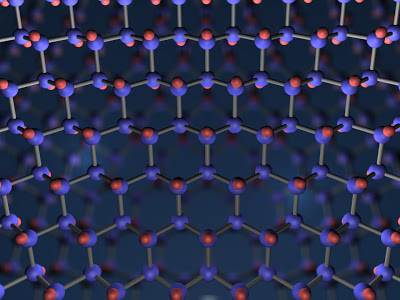
Graphane crystal. This novel two-dimensional material is obtained from graphene (a monolayer of carbon atoms) by attaching hydrogen atoms (red) to each carbon atoms (blue) in the crystal. Credit: University of Manchester
What is huge:
1. Graphene has already has a lot of great properties. Strongest material. Very conductive.
2. Now graphene can be chemically modified to tune the properties even more. Making something highly conductive and highly insulating means all kinds of electrical devices are possible
3. This is opening the door to even more chemical modification.
4. Graphene has already been turned into proof of concept liquid crystal display devices (single pixel) and quantum dots and transistors
Many imagse of the graphene/graphane work
Professor Geim and Dr Novoselov have used hydrogen to modify highly conductive graphene into a new two-dimensional crystal – graphane.
The addition of a hydrogen atom on each of the carbon atoms in the graphene achieved the new material without altering or damaging the distinctive one-atom-thick ‘chicken wire’ construction itself.
But instead of being highly conductive, like graphene, the new substance graphane has insulating properties.
The researchers say the findings demonstrate that the material can be modified using chemistry – clearing the way for the discovery of further graphene-based chemical derivatives.
“Graphene is an excellent conductor and is tipped for many electronic applications,” said Dr Novoselov. “However it was tempting to look at ways to gain additional control of its electronic properties through the use of chemistry.
“Our work proves that this is a viable route and hopefully will open the floodgates for other graphene-based chemical derivatives. This should widen the possible applications dramatically.”
Professor Geim said: “The modern semiconductor industry makes use of the whole period table: from insulators to semiconductors to metals.
“But what if a single material is modified so that it covers the entire spectrum needed for electronic applications?
“Imagine a graphene wafer with all interconnects made from highly conductive, pristine graphene whereas other parts are modified chemically to become semiconductors and work as transistors.”

Brian Wang is a Futurist Thought Leader and a popular Science blogger with 1 million readers per month. His blog Nextbigfuture.com is ranked #1 Science News Blog. It covers many disruptive technology and trends including Space, Robotics, Artificial Intelligence, Medicine, Anti-aging Biotechnology, and Nanotechnology.
Known for identifying cutting edge technologies, he is currently a Co-Founder of a startup and fundraiser for high potential early-stage companies. He is the Head of Research for Allocations for deep technology investments and an Angel Investor at Space Angels.
A frequent speaker at corporations, he has been a TEDx speaker, a Singularity University speaker and guest at numerous interviews for radio and podcasts. He is open to public speaking and advising engagements.

